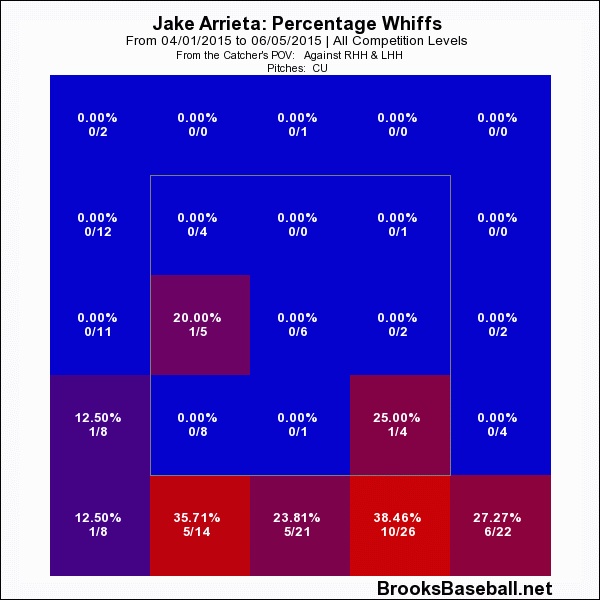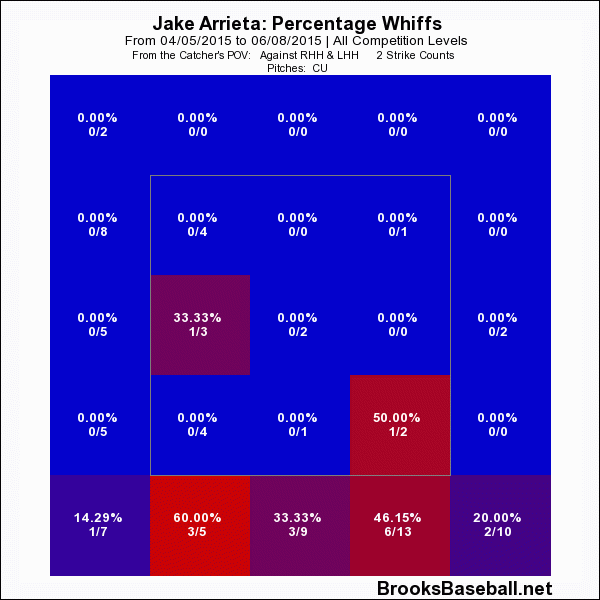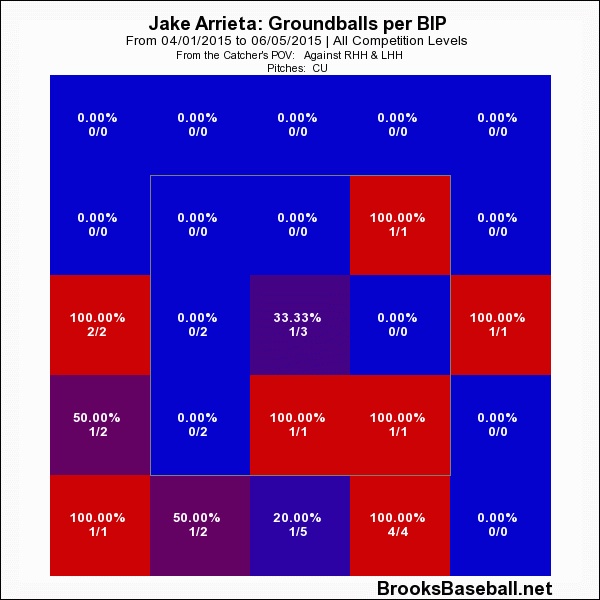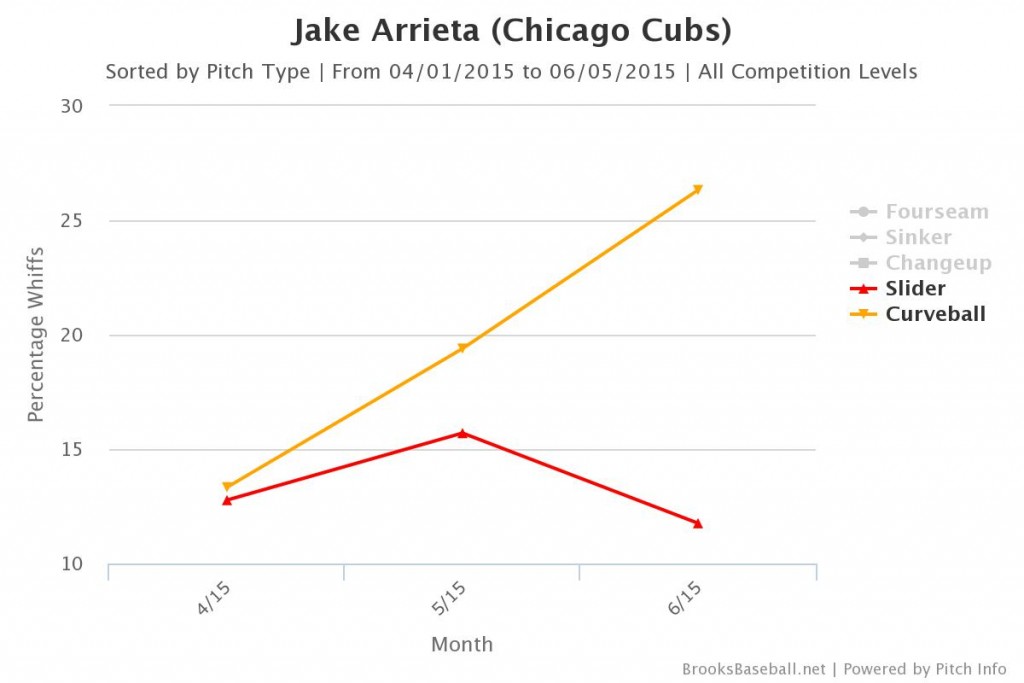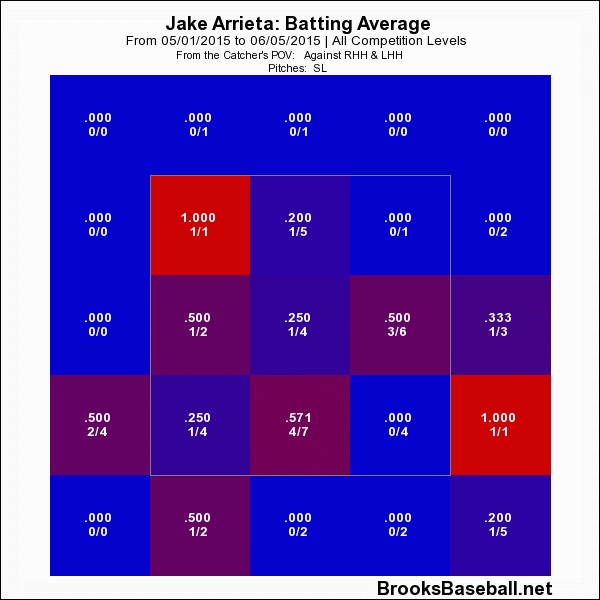One could refer to Jake Arrieta as a dark horse when it comes to the elite arms in the game. When it comes to the top-tier, well-established hurlers, Arrieta’s name is almost never dropped by anyone but locals. That’s fine, it’s almost as if Arrieta is the best secret the North Side of Chicago has to keep.
Another thing that may be a secret to those who don’t dial in with a watchful eye on Arrieta every five days, is his lethal curveball. Yes, Arrieta is known for mainly his sinker and his exceptional slider—but the curveball he throws is extremely potent. It’s something Cubs fans are going to want to keep an eye on in the future of Arrieta’s domination. He doesn’t use his curveball much, although he has increased the usage of the pitch quite a bit since April—up from 10 percent in April to 16 percent in May, and albeit a small sample size—19 percent in his lone June start.
In 2015, Arrieta has used the pitch 14.6 percent of the time, but it jumps past 20 percent when he’s ahead or has two strikes on batters. Here’s how batter’s fare when he throws the curve in any count:
And when he gets two strikes on the opposition, the whiffs down in the zone only get worse:
The nasty bite and late break on this pitch is what’s leaving even some of the better hitters out there swinging at these phantom pitches. Arrieta is making hitter all across the National League (and sometimes the American League—check out the location and percentage of curveballs he got the Royals to whiff on in his May 29th start)… well, look, I hate to keep saying it, but foolish.
And if batters actually do make contact with Arrieta’s bender? Let’s just say he’s winning that battle as well.
In all counts, here’s the groundball map on Arrieta’s curveball:
So yes, even if you’re making contact with one of those fateful curveballs, you’re not going to be heading many places but back to the dugout wondering what just happened.
Batters are currently sporting a .135 batting average against Arrieta’s curveball, the lowest of all his pitches, and are whiffing at a 38.5 percent rate per swing, the highest clip of all his pitches by a large margin (by 12 percentage points) and good for sixth in the NL.
Historically, Arrieta relies on his slider more often than his curve, and that’s still the case. But Arrieta did decrease his slider usage by just a tick over five percentage points from April to May (33.8 percent to 28.7) while increasing his curve usage from 10.8 percent to 16.4 percent. And thus far, the curve has just been a more effective pitch, not that the slide piece is a slouch, but he’s causing hitters to whiff at a significantly higher rate on his curveball than the slider right now.
From a numbers standpoint, there is good reason for the decreased usage of the slider other than a lowering whiff rate. Arrieta’s slider is currently taking somewhat of a beating. In April, with a 141 pitch sample size, Arrieta’s batting average against on his slider was just .146. In May, with a 172 pitch sample size, that average jumped to .326.
Check out the batting average map on his slider from April, and then from May.
Arrieta no doubt can squelch hitters with both his curve and his slider, but right now, with it’s nasty bite and crazy sinking action, his curveball is serving better at the task. The best part about this is his slider is still exceptional and can certainly get the job done. Arrieta will be able to switch between the two while also incorporating his excellent sinker and fastball, and from time to to time even sprinkling in his changeup into the repertoire. The fact that Arrieta’s slider, which many pointed to as a big reason for his breakout 2014, hasn’t been as dominant is impressive both because he’s still performing at a high level despite his supposed best pitch lagging a bit and because it shows just how good the rest of his arsenal is, allowing him to go to other offerings when something isn’t working as well as he’d like. You can never have too many plus pitches in your bag of tricks, and Arrieta is proving that quite well in 2015.
Lead photo courtesy of Matt Marton-USA TODAY Sports

